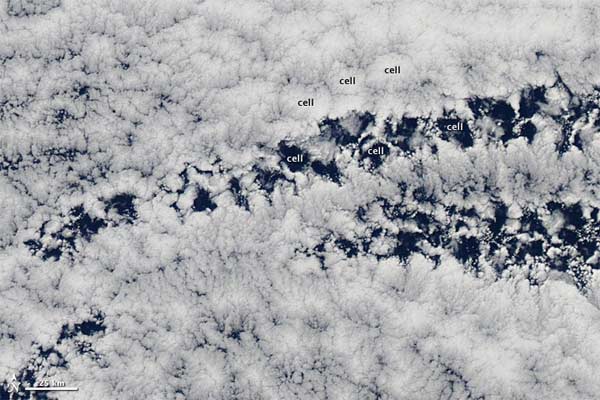
Strange Honeycomb Cloud Patterns Explained

The honeycomb-like patterns of clouds often seen over the open ocean are known to shift, with patches of sky alternately becoming clear or cloud-covered. Scientists now think they know what drives these shifting fields of holey clouds.
Researchers studying these cloud patterns in models and real data have found that rain and alternating air movements form the patterns and cause them to shift in the sky while the clouds themselves remain cohesive structures — following a principle called self-organization that also explains phenomena like flocks of birds, shifting sand dunes and the synchronized flashing of fireflies.
Understanding how and why these clouds shift through the sky is important because "the pattern of the clouds affects how much of the sun's energy gets reflected back into space," said study team member Hailong Wang of the Department of Energy's Pacific Northwest National Laboratory, in Richland, Wash. In turn, understanding how much solar energy passes through to the Earth's surface helps scientists better understand and model the planet's climate.
Classic convection
Scientists call the honeycomb-patterned clouds "open-cell clouds"; they are low, flat clouds that, to someone peering down from an airplane, resemble a quilt. The quilt patches are spaces of open air framed by walls of clouds. [See different cloud shapes and what they mean.]
The honeycomb is created by a simple form of convection, air movement caused by warm air rising and cold air falling (the same phenomenon that happens in a pot of boiling water).
The "pure" form of this convection can be seen in a setup of two flat, horizontal plates separated by a thin liquid layer. If the bottom plate is heated up, the warm liquid near it rises, pushing down the cold liquid from near the top plate. These upward and downward movements (called updrafts and downdrafts) start to form verticals "walls" in the liquid.
Sign up for the Live Science daily newsletter now
Get the world’s most fascinating discoveries delivered straight to your inbox.
If the bottom plate is heated up uniformly, then the updrafts and downdrafts create hexagonal cells in the liquid surface that look like a honeycomb.
But Earth's oceans are not heated uniformly, so the open-cell clouds that result from convection don't look perfectly hexagonal.
The atmosphere is also a complex place where factors besides heating come into play to determine when and where clouds form. For example, aerosols — tiny particles of dust and dirt floating in the air — serve as surfaces for water to collect on, forming cloud droplets, so the number and size of aerosols can change the size of cloud droplets and determine whether clouds will produce rain. It's this relationship that Wang and his colleagues examined in computer models of honeycomb clouds.
Shifting clouds
The model simulated low-lying clouds over the ocean, feeding them with just enough aerosols to produce rain and the honeycomb pattern.
The patch of clouds as a whole always kept the same patchwork pattern, but individual cells within the quilt would disappear and re-form over the course of a couple of hours. To figure out what caused this cycling, the team examined the air movements in the area.
Strong updrafts were seen at the cloudy vertical walls of the honeycomb (as air rose and cooled and water condensed). Eventually, enough water condensed out to form rain, and the now cooler air sank, forming a downdraft. When adjacent downdrafts neared the ocean surface, they followed it to flow outward, eventually collided, warmed up near the surface and flowed back up again as a new updraft. The new updraft was now shifted over in space, accounting for the apparent disappearance and reappearance of the honeycomb cells.
Measurement of wind and rain taken by ships on the ocean supported the findings of the computer simulation, showing that outflows from rain in different parts of the sky collide at the ocean's surface and flow back up again.
"Together, these analyses demonstrated that the rearrangement is a result of precipitation and that clouds belonging to this kind of system rain almost in unison," said study team member Graham Feingold of the National Oceanic and Atmospheric Administration in Boulder, Colo.
Clouds are important influences on the planet's climate: They reflect solar radiation back to space, having a cooling effect, while cloud-free spaces let that radiation reach the Earth's surface to warm up the planet. It is not easy for scientists to incorporate clouds into climate models, which are series of equations describing the interactions between nature's various processes. Understanding the cloud shift will help refine models.
"We've teased out the fundamental reasons why the open-cell clouds oscillate. Being able to simulate these clouds in computer models, we gain more insights into the physics behind the phenomenon," Wang said. "This will help us to better interpret measurements in the real atmosphere and represent these clouds in climate models."
The study is detailed in the Aug. 12 issue of the journal Nature.
- How to Read Clouds
- Weather 101: All About Wind and Rain
- The World's Weirdest Weather

Andrea Thompson is an associate editor at Scientific American, where she covers sustainability, energy and the environment. Prior to that, she was a senior writer covering climate science at Climate Central and a reporter and editor at Live Science, where she primarily covered Earth science and the environment. She holds a graduate degree in science health and environmental reporting from New York University, as well as a bachelor of science and and masters of science in atmospheric chemistry from the Georgia Institute of Technology.









